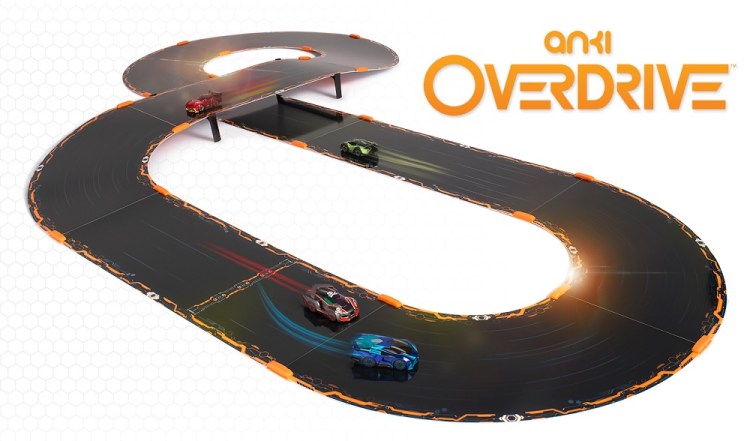Anki put six years of artificial intelligence research to good use when it launched its robot battle-car racing game in the fall of 2013. Now it is revealing a major upgrade that will enable players to create customizable race tracks and drive up to six new cars.
The Anki Overdrive base package will debut for $150 this September. That may sound like a lot for toy racing cars. But the A.I. in these cars is very high end, and the overall system is starting to look brilliant. The brilliant financial part is that Anki has now made it possible for its racing-car enthusiasts to spend a large amount of money to build their own dream race tracks.
The first product that Anki launched had an oval race track with sensors built into it. Those sensors could detect where the cars were at any given time, and the A.I. in the cars was smart enough to drive better than a human could. You controlled your own car with an iPhone, but rather than fully drive it with the touch screen, you could control the car’s speed and whether to fire its weapons at another car. The cars would all race around the track themselves, turning at the perfect time. You could roll up the track and spread it out on any floor. Anki updated the product last year with more cars, and it was one of the best-selling toys on Amazon.com in 2014. Players have driven more than 800,000 real miles with the 2-inch cars.
“With our first product, we were just scratching the surface,” said Mark Palatucci, the co-founder and chief product officer of Anki in San Francisco, in an interview with GamesBeat. “Ever since we’ve started, we’ve always wanted to give people the ability to customize their tracks. We kept hearing that. But it wasn’t easy. The A.I. vehicles have to learn the track.”
Palatucci said the company had to create more than 100 hardware prototypes over a period of years to create the Anki Overdrive tracks.
“We needed to work on it to deliver an ideal experience,” Palatucci said.
The company still has time to tweak the product since it won’t ship for eight months. But it is showing the product to retailers, who are making buying decisions now.
Anki Overdrive’s biggest feature is a modular race track, which you can take apart and reassemble as you wish. You can easily snap the track pieces together via magnetic connectors. So now you can route the cars around the furniture in your living room, rather than finding a big space to lay out the oval track.
Besides launching modular tracks, Anki is also releasing a set of robotic “supercars” that can race around the tracks. Enemy A.I. commanders and their crews can drive those supercars in the game’s campaign mode, and you have to square off with them to advance your own achievements. You can configure the tracks any way you want, and the supercars will be able to drive on them without crashing. The cars will use their A.I. smarts to try to beat other cars and take your car out using weapons and other tricks.
That takes a lot of A.I. sophistication, but it was made easier by the design of the tracks, which uses a special ink and optics technologies. Palatucci said each segment of track has markers underneath the faux black pavement, which the cars can see through but the human eye cannot. The markers tell the cars what they should be doing, such as speeding up or getting ready for a sharp right turn or a jump. The cars scan the track 500 times a second for the markers that will tell it to change its racing behavior and enable it to steer precisely on any track configuration. This is one reason why each car has a camera and a 50-megahertz computer in it, he said.
The modular tracks will also work with the older Anki Drive cars once they’ve had a software upgrade. You’ll be able to create eight different tracks with the starter Anki Overdrive kit, and up to 20 if you buy track accessories. The track types include an intersection where the cars may crash into each other and a tile that causes the cars to do a 180-degree turn. There’s also a speed title that gets the cars to speed up and a corner title that enables cars to take turns at top speed.
Anki is unveiling the new version in advance of the Toy Fair 2015 trade show in New York next week.
Palatucci won’t say how many car kits Anki has sold, but he added, “We had a fantastic holiday season.”
Anki Overdrive will launch in September in the U.S., United Kingdom, and Germany. You’ll be able to cross-play with cars controlled by either iOS or Android devices for the first time. The base starter kit will come with two supercars and 10 track parts, and you can buy accessories that will give you the ability to build elevated tracks or add guard rails. The starter kit also has a four-car charger, two risers, and a tire-cleaning kit. Eight expansion track packs and more cars will be available for purchase.
Two cars, dubbed Skull and Ground Shock, will be in the base kit. Two more cars, Nuke and Thermo, will be sold separately. And two more cars are yet to be revealed.
“We wanted to put much more visual detail in the cars,” Palatucci said. “Now they are hand-painted.”
Anki was founded in 2010 by Carnegie Mellon Robotics Institute graduates, and it has raised more than $50 million. Anki has 80 employees.
VentureBeat's mission is to be a digital town square for technical decision-makers to gain knowledge about transformative enterprise technology and transact. Learn More






